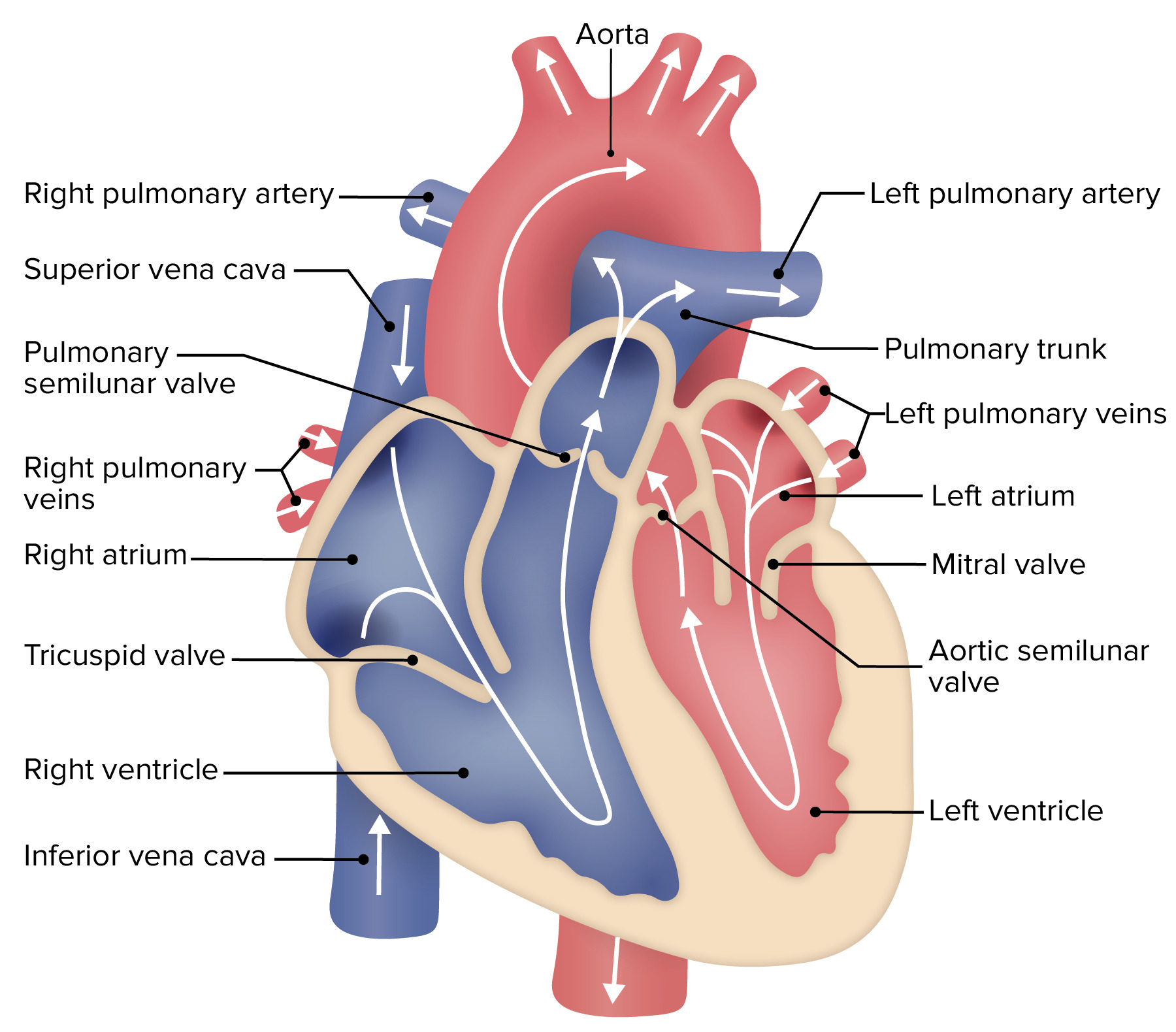Playlist
Show Playlist
Hide Playlist
Intracardiac and Vascular Heart Pressure – Cardiac Cycle
-
Slides CardiacCycle CardiacPhysiology.pdf
-
Download Lecture Overview
00:01 Now, let's talk through the pressures that are in the different parts of the heart. 00:06 The reason why this is important is so you better understand what the right ventricle, the left ventricle, how they are changing in response to their dynamic environments. 00:20 Because the left ventricle is larger, it has more wall mass because it has to push blood throughout the whole body, versus the right ventricle, smaller, has a reduced wall mass because it only has to push blood through the lungs. 00:36 So, what is blood pressure returning to the heart at? By the time it gets into the right atrium, it’s usually between 0 to 4 mmHg. 00:47 And that is the blood coming from both the superior and inferior vena cavas. 00:54 As blood travels through the right atrium at 0 to 4, it enters into the right ventricle. 01:01 The right ventricle has a systolic and a diastolic pressure, just like the left ventricle. 01:06 However, its systolic pressure is only 25 mmHg. 01:11 Its diastolic pressure is 4 mmHg. 01:15 Pushes blood up into the pulmonary artery. 01:18 Pulmonary artery pressures are somewhere around 25 mmHg and the diastolic is around 10. 01:26 You might ask, ‘Okay. 01:27 Well, then why is diastolic 10 there when I just said that in the right ventricle it’s 4.’ Remember, you have semilunar valve in the pulmonary artery. 01:40 So, once you push blood from the right ventricle into the pulmonary artery, eventually that valve will close, and that's going to allow the right ventricular pressures to be lower than the pulmonary artery pressures because of the valve being present there. 01:57 When blood returns from the lungs into the left atrium, it’s somewhere around 8 to 10 mmHg. 02:06 If we look at the left ventricle, it generates pressures all the way up to about 120 mmHg and its diastolic pressure is about 10. 02:16 If we look at the systemic circulation, we’re going to use just the normal typical numbers of 120/80 mmHg. 02:25 That is your systolic and diastolic pressure. 02:28 Same thing happens here. 02:29 Diastolic pressure is 80, but if you look at left ventricular diastolic pressure, it’s only 10. 02:35 What is the difference? The aortic valve. 02:38 That valve closes and keeps pressure in the systemic circulation, but allows the pressure within the left ventricle to fall. 02:48 Why are the systolic pressures matched? Because that is the force you’re imparting to the blood that is leaving the left ventricle and entering into the systemic circulation. 03:00 These pressures set up our high and low blood pressure circuits. 03:05 So, if you think about the left ventricle, it is in the high pressure circuit. 03:10 When it pushes blood out to the systemic circulation, this is where we get our 120 mmHg. 03:17 The right ventricle, however, is in a low blood pressure circuit, meaning that it receives blood back to the heart at very low levels, 0 to 4. 03:27 It pushes it out only about 20 to 25 mmHg. 03:32 So, you can understand why the blood vessels and the whole structures associated with these two circuits are going to be a lot different from each other. 03:41 Anything in the high pressure circuit is going to have to be built in such a way that it can handle high pressure. 03:48 It’s going to have to have more smooth muscle in the walls of the vesicles. 03:51 They're going to have to have collagen fibers, so they have higher tensile strength. 03:56 Versus low blood pressure circuits, they can be thinner, more easily collapsible because they don't have to handle such high pressures.
About the Lecture
The lecture Intracardiac and Vascular Heart Pressure – Cardiac Cycle by Thad Wilson, PhD is from the course Cardiac Physiology.
Included Quiz Questions
Why are the pressures inside the right side of the heart lower than those of the left side of the heart?
- The right side of the heart only has to pump blood to the lungs, and the left side has to pump blood to the whole body.
- The right side of the heart only receives half the blood volume that the left receives.
- The aortic valve is easier to open so the left ventricle can create more pressure.
- The right side of the heart has to overcome more pressure from the pulmonic valve.
- There is no difference in the pressure of the right and left sides of the heart.
Which of the following represents the normal systolic pressure in the right ventricle?
- 15-25 mmHg
- 0-8 mmHg
- 2-6 mmHg
- 6-12 mmHg
- 70-105 mmHg
Customer reviews
5,0 of 5 stars
| 5 Stars |
|
5 |
| 4 Stars |
|
0 |
| 3 Stars |
|
0 |
| 2 Stars |
|
0 |
| 1 Star |
|
0 |





